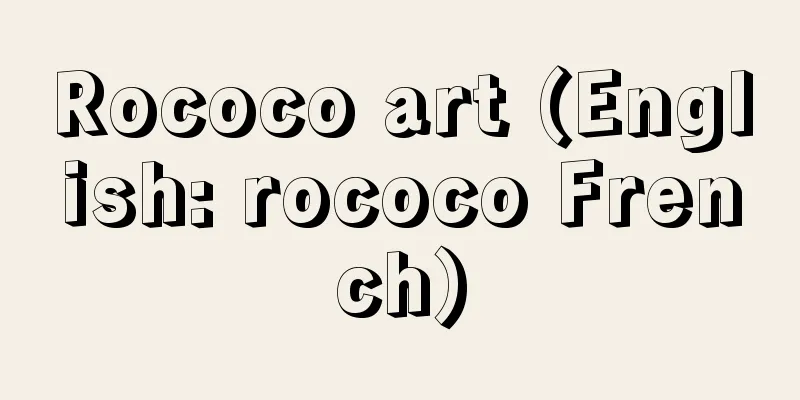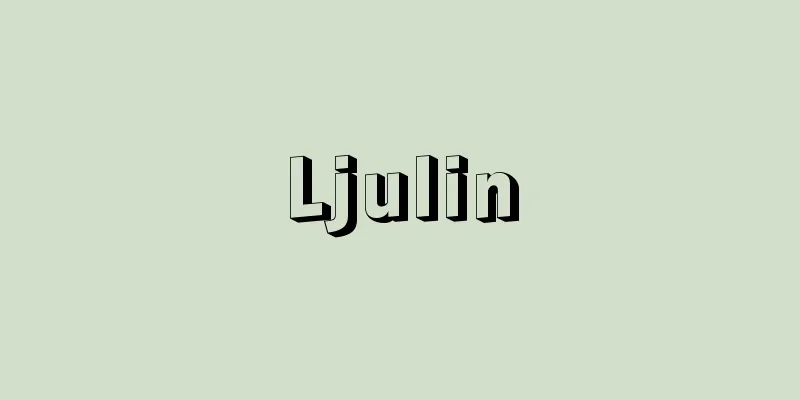Rococo art (English: rococo French)

|
Rococo is a word derived from rocaille decoration, and was originally a derogatory term for the decorative style that was popular in 18th century France, mainly during the Regency period (when Philippe II, Duke of Orléans, was regent for Louis XV, 1715-1723) and during the reign of Louis XV (reigned 1715-1774).However, today it is used to name the European art style of the 18th century before the French Revolution, including not only interior decoration but also painting and architecture, and also refers more broadly to the culture and trends of the time. While the principles of form and style can be seen as an extension of the Baroque style in many ways, the emphasis is on delicacy, elegance, and lightness, and in terms of spirit and sensibility it is rather considered to be in opposition to the solemnity and authority of the Baroque. The background to the Rococo style can be said to have been a reaction against the era of grand palaces symbolized by Versailles, a sensualism against the intellectualism of the 17th century, and a spontaneous expression of sensory freedom that preceded the idea of social freedom that was soon established by the French Revolution. [Kimio Nakayama] Architecture and interior decorationArchitecture during this period, which favored gatherings in salons in private mansions (hotels) over large-scale banquets in palaces, was limited to small hotels, apartments, or country villas, with a few exceptions. And often the exteriors were rather simple, with emphasis on the elegant harmony of the interior spaces, especially since the introduction of the neoclassical taste during the reign of Louis XV. This new principle of interior decoration appeared in the interior of the Marly-le-Roi mansion, designed by architect Le Pautre at the end of the 17th century, where the mirror panels, which had previously been fully decorated with sculptures and paintings, were white or mostly white except for the arabesque patterns decorating the periphery, emphasizing the lightness of the interior. This style was developed further by architects Germain Bouffran and Gilles-Marie Aubonor. Meanwhile, painters from the end of the 17th century onwards produced flatter, freer and more fantastical scenes than Baroque decoration, as well as Chinese motifs called sanjulie, which were developed by Claude Audran III and Watteau. Rococo architecture can be said to be complete when this type of decoration is combined with plans that emphasize curves such as ellipses, methods of covering columns and beams to unify the interior, and a wide variety of Rococo crafts to form an interior space. Representative examples include the residence of the Duke of Soubise by Bofran, Amalienburg Palace in Nymphenberg Castle by Cuvier, a French architect who was mainly active in Bavaria, and Sanssouci Palace in Potsdam, designed by Georg Wenzeslaus von Knobensdorff (1699-1753) based on sketches by Frederick II himself. [Kimio Nakayama] Painting and sculptureAt the end of the 17th century, a new talent for sensualism began to emphasize the allure of color, in opposition to the mainstream of Academicism, which was already dominated by classicism. Watteau emerged as a new talent in this field. Although most of his activities were still under the reign of Louis XIV, his themes and techniques not only led the Rococo movement, but also best represented its spirit. Themes of conversations between men and women in the countryside, love, music, and dance, such as "Pilgrimage to Cythera" (1717, Louvre Museum), which was painted as his entrance piece for the Academie, became a new genre called "fête-galante" (elegant banquet), and had successors such as Lancret, who had a great influence on the design of panel panels and the painting of ceramics. Watteau's basic themes were theatrical settings of love negotiations and the idea of a paradise-like harmony between nature and humans, and this influenced Boucher and others in the Louis XV era, as well as Fragonard, who represented the final period of Rococo. Maurice Quentin de La Tour, who perfected his own pastel technique under the influence of the Italian painter Rosalba Carriera, who was a female friend of Watteau's, and painted "Portrait of Madame de Pompadour" (pastel), showed delicate colors and agility in depicting human emotions in portraits. Houdon and others showed the same lightness and sharpness in depicting human emotions in sculpture. Greek taste was in vogue in the second half of the 18th century, and before the Revolution, Diderot and others praised moral painting. Chardin was also born out of the influence of Dutch painting and the steadily growing interest in civic life. However, the world of Boucher, who led the neoclassical taste of the Louis XV era under the patronage of Madame de Pompadour, also belongs to the Rococo sentiment dressed in mythical attire, and the moral paintings of Greuze and others are also Rococo in their anecdotal and emotional nature. The world of Chardin, who depicts the everyday life of citizens and casual still lifes that contrast with court life, is also Rococo in terms of his sensitive sense of indoor light and his depiction of anecdotal scenes from everyday life. [Kimio Nakayama] Spread to European countriesRococo Sensationalism, which arose in France, spread to other European countries, mixing with the remains of Baroque tastes and new demands such as civic life and the observation of nature, and exerting some influence. The architecture and interior decorations of South Germany show a mixture of Baroque and Rococo, while the portraits and nature depictions of British artists such as Hogarth and Gainsborough are a fusion of the fascination of Rococo and a new eye. Italy, which was no less impressive in depicting festive spaces, and especially Venice, where artists such as Guardi and Canaletto harmonized festive moods with naturalism in their scenes of ports and canals, and Tiepolo, who painted many decorative paintings throughout Europe, including the wall decorations of the Bishop's Palace in Würzburg, Germany, presented his magnificent mythical scenes as a world of opera. In Spain, Goya, who would later foreshadow the 19th century with his direct view of reality and fantasy, also used Rococo genres as a subject in many of his early tapestry sketches. [Kimio Nakayama] Crafts and FurnitureCompared to the grandeur and sculptural quality of Baroque furniture, especially Louis XIV style furniture, Rococo furniture was far more delicate and refined, with elegant curves added to the legs of chairs and chests of drawers, and the surface finish changed to flat decoration using inlay. Among the various crafts, pottery is what best characterizes the Rococo period. Meissen in Germany had already succeeded in firing hard porcelain in 1710, but Chantilly and Sèvres in France, Buen Retiro in Spain, Capodimonte in Italy, Chelsea and Derby in England, and other kilns all started out producing soft pottery, but opened in the first half of the 18th century and produced a wide variety of pottery based on designs supplied by painters and sculptors. [Kimio Nakayama] The end and influence of RococoThe Rococo sentiment came to an end with the French Revolution, and not only the works of Watteau and others, but even those of Chardin and others, fell into disuse for a long time. It was not until the middle of the 19th century that their works were rediscovered and put on public display at the Louvre and other museums. This rediscovery was, of course, linked to trends in 19th century art, such as the rediscovery of Watteau's color techniques and portraiture, and the discovery of a tradition in Chardin's eye for still life. It can be said that the development of Rococo color and an eye for everyday life and nature led to a large extent to the development of 19th century art. [Kimio Nakayama] "Grand World Art 17: Rococo Art" edited by Yamada Chisaburo (1976, Gakken) " "Rococo - France in the 18th Century" by M. von Behn, translated by Iizuka Nobuo (1970, Risosha) " "Grand World Art 16: Watteau and Rococo Art" translated by Sakamoto Mitsuru and Nakamura Shinichiro (1977, Kodansha)" [References] | | | |1751 Oil on canvas, Metropolitan Museum of Art Boucher's "The Makeup of Venus" Painting by Herold, c. 1723, hard porcelain, tea bowl height 4.8cm, saucer diameter 12.4cm, owned by the Metropolitan Museum of Art Meissen porcelain (tea bowl and saucer) 1782 soft-paste porcelain (Collection of the Metropolitan Museum of Art ) Sèvres porcelain vase with lid Source: Shogakukan Encyclopedia Nipponica About Encyclopedia Nipponica Information | Legend |
|
ロココとはロカイユ装飾に由来することばで、本来は18世紀フランスの、主として摂政(せっしょう)時代(オルレアン公フィリップ2世がルイ15世の摂政であった時代、1715~1723)およびルイ15世(在位1715~1774)時代に流行した装飾様式への蔑称(べっしょう)であるが、今日では室内装飾のみならず、絵画、建築をも含めたフランス革命前の18世紀のヨーロッパ美術様式の名称として用いられ、またさらに広く同時代の文化、風潮をもさす。 形態や様式の原理そのものはバロック様式の延長とみることのできる部分が多いが、繊細さ、優雅さ、軽快さが強調され、精神的、感覚的には、むしろバロックの荘重さ、権威性に対立するものと考えられる。ベルサイユに象徴される大宮殿時代への反発、17世紀主知主義に対する感覚主義、そしてやがてフランス革命によって確立される社会的な自由の観念に先行する感覚的自由の自発的な表れが、ロココ様式の背景にあったというべきだろう。 [中山公男] 建築と室内装飾宮殿での大規模な祝宴よりも、私的な邸館(オテル)のサロンでの集いを好んだこの時期の建築は、若干の例外を除けば、小規模のオテル、マンション、あるいは田園の別荘に限られる。そしてしばしば外観はむしろ簡素にし――とくにルイ15世時代の新古典趣味の導入以来――室内の空間の典雅な調和に重点が置かれる。この新たな室内装飾の原理は、17世紀末、建築家ル・ポートルによってなされたマルリー・ル・ロワMarly-le-Roiの邸館の内部で現れたが、そこでは従来、彫刻や絵画によって全面に装飾されていた鏡板が、周辺部を飾る唐草文(からくさもん)のほかは白地、もしくは大半を白地とし、室内は軽やかさが強調されるようになっている。 この形式を建築家ジェルマン・ボフラン、ジル・マリ・オプノールが発展させる。一方、画家たちも17世紀末以降、バロック装飾に比して平面的、そしてより自由で幻想的な情景や、サンジュリーと名づけられる中国風のモチーフを生み出し、クロード・オードラン3世、ワトーたちによって展開される。 こうした装飾が、楕円(だえん)形などの曲線を重視するプラン、柱や梁(はり)を覆い室内を一体化する手法、多彩なロココ工芸などとともに室内空間を形成するとき、ロココ建築が完成するといってよいだろう。代表的な作例は、ボフランによるスービーズ公の邸館、あるいはフランスの建築家であるが主としてバイエルン地方で活躍したキュビエによるニュンフェンブルグ城内のアマリエンブルク宮、フリードリヒ2世自身のスケッチに基づいてクノーベルスドルフGeorg Wenzeslaus von Knobensdorff(1699―1753)が設計したポツダムのサンスーシ離宮などがあげられる。 [中山公男] 絵画・彫刻17世紀末、すでに古典主義を主流とするアカデミズムに対して、色彩的な魅惑を重視する姿勢が現れているが、この感覚主義の新しい才能としてワトーが登場する。彼の活動の大半はまだルイ14世の治下にあったが、彼の主題、技法はロココを先導しただけではなく、その精神をもっともよく代表している。アカデミー入会作品として描かれた『シテール島の巡礼』(1717・ルーブル美術館)など、田園での男女たちの会話、愛、音楽、ダンスの主題は、「雅宴」(フェート・ガラント)として新たなジャンルとなり、ランクレなどの後継者をもち、鏡板の図案や陶器の絵付(えつけ)にも大きな影響を及ぼした。愛の駆け引きという演劇的な設定と、自然と人間の調和という楽園図風の発想とがワトーの基本的な主題であるが、これは、ルイ15世時代のブーシェたちにも、ロココの終末期を代表するフラゴナールたちにも影響を与えている。 ワトーの女友達であったイタリアの画家ロザルバ・カリエラの影響下に独自なパステル画技法を完成させ、『ポンパドゥール夫人の肖像』(パステル)を描いたモーリス・カンタン・ド・ラ・トゥールは、肖像画の分野で繊細な色彩、機敏な心理描写をみせる。同じような軽やかさと鋭い心理描写を彫刻で示したのがウードンたちである。 18世紀後半にはギリシア趣味が流行し、大革命前にはディドロたちによって道徳的絵画が称揚される。またオランダ絵画の影響と、着実に成長する市民生活の目がシャルダンを生んでいる。しかし、ポンパドゥール夫人の庇護(ひご)下にルイ15世時代の新古典趣味をリードしたブーシェの世界も、神話的な装いをまとったロココ的情緒に属しているし、グルーズたちの道徳的絵画も、その逸話性、情緒性の点でやはりロココ的である。宮廷的生活と対照的な市民の日常となにげない静物を描くシャルダンの世界も、繊細な室内の光に対する感覚や、日常の逸話的情景を描くという点で、やはりロココ的である。 [中山公男] ヨーロッパ諸国への伝播フランスにおこったロココ的感覚主義は、バロック趣味の残存、市民的な生活や自然への観察といった新たな要請と混在しつつ、ヨーロッパ各国に伝わり、なんらかの影響を与えている。南ドイツの建築や室内装飾はバロックとロココの混在を示し、イギリスに生まれたホガース、ゲーンズバラたちの肖像画や自然描写は、ロココの魅惑と新たな目との融合である。祝祭的な空間を描くことでは他に劣らなかったイタリア、とりわけベネチアでは、グアルディ、カナレットたちが港や運河の情景によって祝祭的な気分と自然主義を調和させ、ドイツのウュルツブルクの司教館の壁面装飾などヨーロッパ各地で多くの装飾画を描いたティエポロは、その壮大な神話的情景を、いわばオペラ風の世界として提示している。スペインでは、やがてその現実直視と幻想性において19世紀を予告するゴヤも、初期には多くのタペストリーの下絵によってロココ風俗を題材としている。 [中山公男] 工芸・家具バロック、とくにルイ14世様式の家具の荘重さ、彫刻性に対して、ロココの家具ははるかに繊細さと洗練を加え、たとえば椅子(いす)やたんすの脚なども優雅な曲線を加え、表面の仕上げも寄木(よせぎ)細工による平面的な装飾に変化する。 さまざまな工芸品のなかで、もっともよくロココ時代を特徴づけるのは陶器類である。ドイツのマイセンは、すでに1710年に硬質磁器の焼成に成功したが、フランスではシャンティイ、セーブル、スペインではブエン・レティロ、イタリアではカーポディモンテ、イギリスではチェルシー、ダービーなどが、いずれも最初は軟質陶器であったが18世紀前半に開窯し、画家・彫刻家たちの供給するデザインによって多彩な陶器類を生み出している。 [中山公男] ロココの終末と影響ロココ的な情緒は、フランス革命によって終末を迎え、ワトーたちの作品のみならずシャルダンたちの作品さえ、かなり長期にわたって顧みられなくなる。彼らの作品が再発見され、ルーブル美術館などでふたたび公開されるのは19世紀なかばになってからである。この再発見は、いうまでもなく、19世紀の美術の動向が、たとえば色彩的な技法や人物描写でワトーを再発見し、静物への目でシャルダンに伝統をみいだしたなどということに関連する。ロココの色彩、日常生活や自然への目の開発が、かなりの部分で19世紀美術の展開へとつながるといえるだろう。 [中山公男] 『山田智三郎編者『大系世界の美術17 ロココ美術』(1976・学習研究社)』▽『M・フォン・ベーン著、飯塚信雄訳『ロココ――18世紀のフランス』(1970・理想社)』▽『坂本満・中村真一郎訳『グランド世界美術16 ワトーとロココ美術』(1977・講談社)』 [参照項目] | | | |1751年 油彩メトロポリタン美術館所蔵"> ブーシェ『ビーナスの化粧』 ヘロルト画 1723年ころ 硬質磁器 ティーボウルの高さ4.8cm 受け皿の径12.4cmメトロポリタン美術館所蔵"> マイセン磁器(ティーボウルと受け皿) 1782年 軟質磁器メトロポリタン美術館所蔵"> セーブル磁器(蓋付き花瓶) 出典 小学館 日本大百科全書(ニッポニカ)日本大百科全書(ニッポニカ)について 情報 | 凡例 |
Recommend
ESCB - ESCB
Please see the European Central Bank page. Source...
Ligularia hodgsonii (English spelling) Ligulariahodgsonii
… [Mitsuru Hotta]... *Some of the terminology tha...
Djeser (English spelling)
The second king of the Third Dynasty of Ancient Eg...
White
〘Noun〙① The name of a color. The color of snow, sa...
Pak Par‐yang (English spelling)
1905‐88 A poet from the Democratic People's Re...
Depopulation and overpopulation - Kasokamitsu
Depopulation and overpopulation are phenomena that...
Neo-classical synthesis
This is an attempt to somehow integrate the micro...
vijñapti-mātra-vāda (English spelling) vijnaptimatravada
…In Indian Buddhism, a Mahayana ideology that aro...
Islamic Philosophy
It was also called "Arabic philosophy."...
Oxalis cernua (English spelling) Oxalis cernua
… [Munemin Yanagi]. … *Some of the terminology th...
Minatogawa Shrine
Located in Tamon-dori, Chuo-ku, Kobe, Hyogo Prefe...
Takahashi Tetsu
1907-1971 A Showa-era novelist and sex customs re...
Error control system
When transmitting digital data over a communicatio...
Kanaya stone
...The rock peaks of sandy tuff, which are connec...
Fisheries Cooperative - Gyokyo
〘Noun〙 Abbreviation of "Gyogyo Kyodokumiai (F...
![Tamana [city] - Tamana](/upload/images/67cc25fb60c5a.webp)






![Volkswagen [company] - Volkswagen](/upload/images/67ccae4a748d6.webp)

